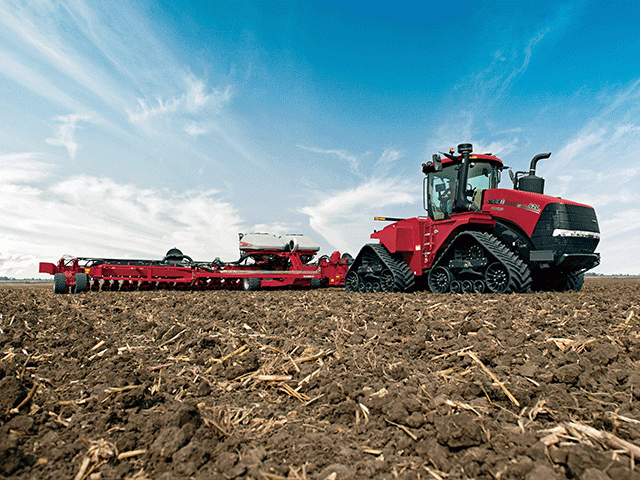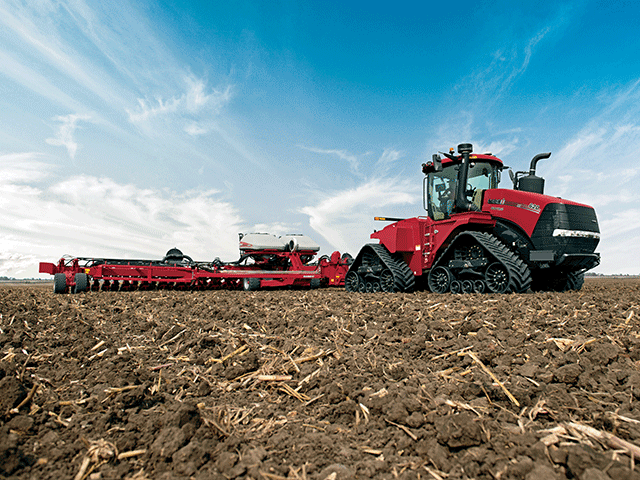MachineryLink
Protect Your Tracks
We wanted to know about tracks for tractors. So, we went to Tony O'Hanlan, tracks business manager at Firestone Ag. With 20 years in the tracks business, he went through the do's and don'ts that will help maintain track life in both the field and over the road.
Here's the interview (and at the end, a few bonus words about care and maintenance).
**
DTNPF: Let's talk tracks. Case, John Deere, AGCO brands, New Holland, Steiger all have track options. What's the market signal to farmers regarding tracks versus wheels?
O'Hanlan: I'm a track person. But the industry really is moving toward tracked machines. Tire machines are always going to be there. Is there a cost (differential)? You're probably talking 25 to 40% (more). And you also have the maintenance side of it too -- the undercarriage. There are a lot of moving parts that need maintenance.
DTNPF: Generally, then, does one work better than the other?
O'Hanlan: There are some who really need a lot of tractive effort in the ground. So, what they do is go wide on tires to try to get more footprint -- you know, doubles or triples. With tracks, they're going to achieve that same kind of (result) with a much narrower footprint. If a farmer is in moist or wet soil, tracks thrive versus the tire.
DTNPF: Farmers find tracked machines with rear tracks only, two tracks and four tracks. Does one have an advantage over?
O'Hanlan: With the four-track machine, you get (superior) tractive effort and lower compaction. But here's what I tell people: When a farmer walks into a dealership and they're paying for a four-track machine -- it's probably double the price, right? Farmers just don't give away money. If a farmer says 'I'm going to pay this amount of money for this machine,' it shows that their yields are bigger, the bushels are bigger, they're making much more money having to work probably a little bit less with this machine overall.
DTNPF: You have 20 years of experience in this business, how do you help customers make decisions on tracks?
O'Hanlan: Some of it is a matter of time used. In California, some run tracks 1,500 to 2,500 hours in a year -- and it's crazy how (often) they turn these things over. In the Midwest, North or South, its 300 to 700 hours. But most farmers who buy a track machine are pretty educated about it. But we always ask what they're doing, try to understand how their last tracks performed. They might say, 'My tracks didn't hold up.' OK, let's figure out why. We will see that the undercarriage probably isn't in the best condition, or maybe they're using too narrow of bogie wheels. Bogie wheels distribute the weight of the machine. So, if you have too narrow of bogie wheels or mid rollers, you're going to cause that track to flare up a little bit on the outside. You're not going to get very good wear on it.
DTNPF: Let's talk about the undercarriage a bit more.
P[L1] D[0x0] M[300x250] OOP[F] ADUNIT[] T[]
O'Hanlan: It's important to make sure your undercarriage is in good condition. That will allow the farmer to achieve their lowest cost per hour on the tracks. An undercarriage that not in very good condition, with steel exposed, will underachieve on the overall life of the track.
DTNPF: Tell us about the Pro Edge design. What is it for?
O'Hanlan: Firestone developed the Pro Edge design. It is a bump on the outer edge of the track of anywhere from 5-9 millimeters. This gives the track resistance to cuts and abrasions.
DTNPF: What's the biggest enemy of tractor tracks?
O'Hanlan: It is (operators) running down the road at 20 to 25 miles an hour. Don't ever stop, and you smell rubber burning. That is the time to stop. Once you expose the chords on a track, you're on borrowed time. When you're roading, consider the crown of the road. That means the track on the right side is going to be a little bit more beat up. My major concern is going to be the heat.
DTNPF: How should an operator choose a track given a particular farming operation?
O'Hanlan: If a farmer says he is driving 20 miles between fields, he is going to need a roading track, which is going to be the 2-inch tread height and a 6-inch pitch. If a farmer only cares about his tractive effort, then we get him into our class six, which is going to be the 2 3/4-inch tread bar and an 8-inch pitch. One of the most common questions I get is how many hours can I get out of your track?
DTNPF: How many hours can you get on a track?
O'Hanlan: It depends on what the applications are, type of soil, roading, and undercarriage maintenance. We ask what they achieved on their first set, and that usually tells us if they are hard or easy on the machine. The warranty is four years/4,000 hours, whichever comes first, but you have to understand what kind of user it is. A hard user will achieve less hours than an easy user.
DTNPF: What is the maintenance effort on tracks?
O'Hanlan: Let's start from the beginning. When they first put on a track, we always encourage them to throw kitty litter, floor dry, or some kind of abrasive material into the undercarriage. What that does, it helps get rid of the shine on the inside. If you don't get rid of that shine, the heat is going to be much greater than if you were to get rid of it. We encourage them to check the wheels. Check the idler wheels, check the drive wheels. But once you expose steel, the heat builds up quickly.
**
SB: Care and Maintenance of Your Tracks
-- Correct tension. Loose tension may cause slippage between the drive wheel and the inner surface. This slippage will be the main cause of inner surface damage of the rubber track and, potentially, de-tracking.
-- Check undercarriage components. Check the undercarriage components for wear and rubberized surface damage.
-- Avoid sharp turns. Avoid fast, sharp turns and side slope turns. This may cause excessive tread wear, especially on asphalt and concrete surfaces.
-- Minimize operations on rough terrain. Limit use of your machine on large, sharp rocky surfaces and sharp metal objects.
-- Avoid de-tracking on side slope operations. When a tractor transitions from a side slope to a flat surface, the center portion of the undercarriage is unsupported. If the tractor turns during this transition, de-tracking may occur.
-- Minimize slippage. Slippage can cause serious damage to the undercarriage components, inner surface of the rubber track and the cable package.
-- Oil degrades rubber quality. Oil and similar substances degrade rubber quality. Remove them as soon as possible.
-- Choose optimal track width. Narrow tracks (16 inches and 18 inches) are recommended for row-crop operations but are not well-suited for tillage work. Wider tracks (24, 30 and 36 inches) have benefits for traction, flotation, compaction and tracking performance.
-- Use proper ballast. It is important to have the proper ballast to offset the additional weight of the attachment. If machine weight is not balanced, excessive tread wear and other damage can occur.
-- Store equipment inside. Tracks should be kept indoors away from rain. When extended storage is needed, periodic track rotation is recommended to help avoid "shape memory" in the track.
Dan Miller can be reached at dan.miller@dtn.com
Follow him on Twitter @DMillerPF
(c) Copyright 2021 DTN, LLC. All rights reserved.






Comments
To comment, please Log In or Join our Community .